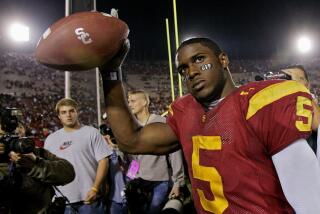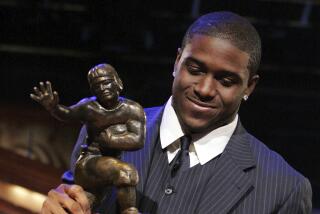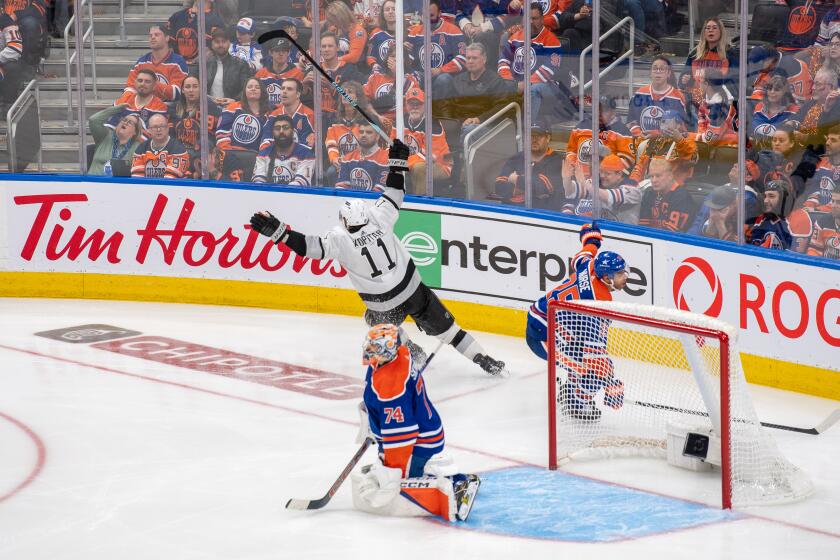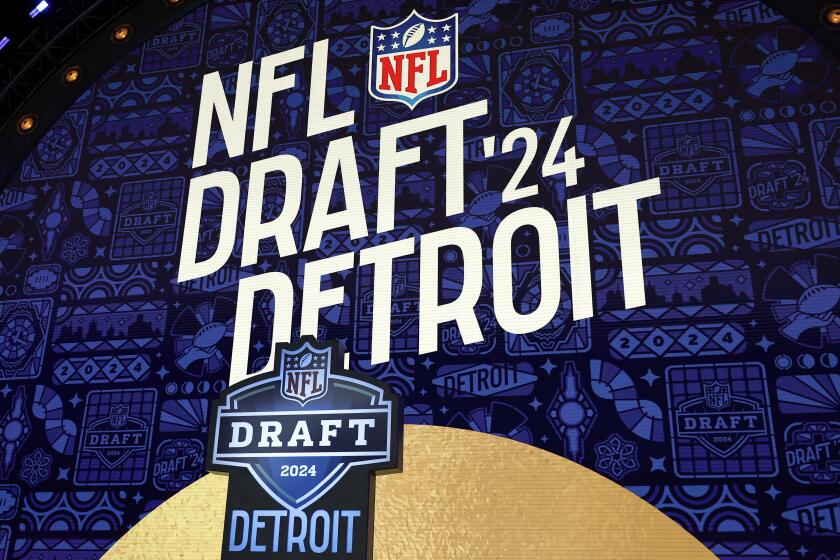BALLOT INITIATIVE
He was already 51 when he made the major leagues in 1965, but in breaking the color barrier for umpires, American League showman Emmett Ashford proved home plate was his stage, baseball his love.
Umpires call them as they see them. And Ashford, until he retired at 56, one year past the recommended retirement age, did that with a flourish.
If a fly ball sailed toward foul territory, the L.A. native would barrel down the baseline to make the call, sometimes speeding by the outfielders. If he called you out on strikes, it was a Hollywood production: He’d shoot his hand from his hip, then straight up to the sky before he dropped the hammer, “Steee-ee-rike!”
Yet, 40 seasons after leaving the game, and 29 years after his death, Ashford remains excluded from the Hall of Fame -- even though he was kept out of the majors simply because of the color of his skin.
“Umpires are supposed to be in the background, but he wasn’t,” said Ashford’s daughter, Adrienne Bratton, who is helping to lead a new effort to get her father’s name on the next ballot. It isn’t the first attempt, but this time she has Jackie Robinson’s widow, Rachel, publicly in her corner.
Today, three players will be enshrined -- Joe Gordon, Jim Rice and Rickey Henderson -- but the last umpire to make it was Nestor Chylak in 1999. And one umpire, Doug Harvey, missed it this time by one vote.
But for umpires, the key measuring stick is years of service, although contributions to the game also come into play. Ashford was in the majors for only five years but had a great eye, a boyish charm, and the quick feet of an avid salsa dancer (which he was), so that watching him work was an event seared into the memory.
To be sure, the election process is no simple matter. There are 289 members of the Hall of Fame, but only eight are umpires, with careers averaging 27.4 years.
“In Ashford’s case, he simply didn’t umpire long enough to warrant going on the ballot ahead of people like [Hank] O’Day, Doug Harvey, Cy Riger . . . “ said Bill Madden, baseball writer for the New York Daily News who is on the 11-member Historical Overview Committee that creates the ballot for managers and umpires.
If Ashford’s name makes the ballot, a separate 16-member committee then votes. Election requires 12 votes.
“As far as breaking the color line,” Madden said, “it was a notable achievement, but I don’t think you can put somebody in the Hall of Fame just on that alone.
“Let me give you an example. Buck O’Neil didn’t get into the Hall of Fame. The Veterans Committee didn’t put him into the Hall of Fame, and this is a committee that voted on strictly Negro League guys. Buck O’Neil was a groundbreaker in every way, shape or form.
“The reason Buck O’Neil, I suspect, was not voted into the Hall of Fame,” Madden said, “was because he was a good Negro League player, not a great Negro League player.”
Zev Chafets, author of “Cooperstown Confidential,” noted that the Hall has “a convoluted history of grappling with racial issues in baseball.”
In Ashford’s case, no one seems to question that he brought something special to the game after laboring in the minor leagues for 15 years, 12 of them in the Pacific Coast League.
“If you watched PCL games or were involved in baseball around L.A., you knew Emmett Ashford,” said Mike Port, Major League Baseball’s vice president of umpiring, who saw Ashford during the umpire’s PCL days.
“And if you didn’t like Emmett Ashford, you had to be visiting the planet.”
Tom Verducci, senior writer for Sports Illustrated who is on the 16-member committee that has the final vote, wants to look beyond length of service.
“I think you also look at, you know, did an umpire do something to change or elevate the profession?” Verducci said. “And that’s why I think a guy like Emmett Ashford deserves notice, or at least some serious discussion, because clearly he did, even if it was for a brief period of time.”
The impact of Ashford isn’t lost on Chuck Meriwether, who in 1993 became the first black umpire in the American League since Ashford’s retirement in 1970.
“We have a black president right now,” said Meriwether, in his 18th season and one of three black umpires currently in the majors. “Can you just imagine a kid -- 10, 11 years old -- and they see him on TV and think, ‘I have a chance and I have the possibility of doing that.’ And when I stop and think about Emmett, it just lets me know I could fulfill that dream.”
Ashford’s dream was to be a major league umpire, a commitment he made when he heard Branch Rickey had signed Jackie Robinson to the Brooklyn Dodgers in 1945. But first Ashford had to break the minor league color barrier for umpires, which he did.
There was no mistaking Ashford had style -- French cuffs, gleaming cuff links and shoes buffed to a pristine shine. And he always brought a typewriter with him on the road so he could answer fan mail. He signed autographs before and after games.
During games, he was accurate and courteous. Once, when a 3-and-0 count turned into a walk, Ashford told the batter, “That, sir, is a ball, and you may now proceed in the general direction of first base.”
Some players couldn’t even get mad at him. Tom Tresh of the New York Yankees once said his anger with Ashford after a disputed call quickly died “because the harder I tried, the more he kept saying: ‘Now Tommy, now Tommy.’ ”
After umpiring the 1970 World Series, Ashford said he was going out on top. Bratton said the Series was his “icing on the cake,” but to her, the icing would be seeing her father in the Hall. Supporters include students from Chapman University, his alma mater, though the coup de grace is Rachel Robinson’s letter to the Hall.
“I have intimate knowledge of the challenges he faced,” Robinson wrote. “At that time in America, the need for social change was intense and still to come. Mr. Ashford carried out the role with great skill, determination and courage, thereby, creating opportunities for others to follow him.”
Brad Horn, spokesman for the Hall, said “the letter carries significant presence” and “adds a great deal of credibility to the cause.”
Bratton doesn’t doubt her father will get in one day, “because he’s supposed to be there,” she said.
“He put fans in the stands,” she said, recalling how Terry Cannon, president of the Baseball Reliquary, where Ashford was inducted last year into the museum’s Shrine of the Eternals, was one of those fans.
It was 1966, the year Ashford would call his first major league game, and Cannon was 13. He had read that Ashford would be behind the plate at the brand-new Anaheim Stadium and went.
“He didn’t let me down,” Cannon said.
After the game, Cannon waited in the stadium parking lot to get an autograph from Ashford. He still has it.
Ashford might not be a member of the Hall of Fame, but he is close by.
His ashes were spread at Cooperstown, the New York home of the Hall of Fame, and a tombstone with his name lies in Lakewood Cemetery there. Inside the Hall, he has a presence too: a one-inch-thick file and a baseball signed from 1966.
Bratton, 67, who teaches salsa dancing -- the kind her father loved, especially at the old Club Alabam on Central Avenue -- will keep pushing.
“He’s already there in spirit,” she said. “Just make it official.”
--
--
(BEGIN TEXT OF INFOBOX)
2009 Inductees
A look at the players to be inducted today into the Baseball Hall of Fame:
RICKEY HENDERSON
* Personal information: Born on Dec. 25, 1958, in Chicago. Threw left- handed, hit right-handed.
* Teams: Oakland, 1979-84, 1989-93, 1994-95, 1998; New York Yankees, 1985-89; Toronto, 1993; San Diego, 1996-97, 2001; Angels, 1997; New York Mets, 1999-2000; Seattle, 2000; Boston, 2002; Dodgers 2003.
* Career highlights: Was a 10-time All-Star with .279 lifetime batting average, 3,055 hits and 297 homers. Holds the all-time record for steals with 1,406, runs scored with 2,295, unintentional walks with 2,129 and home runs leading off games with 81. Won the 1990 AL Most Valuable Player award.
JIM RICE
* Personal information: Born on March 8, 1953, in Anderson, S.C. Threw and hit right-handed.
* Team: Boston, 1974-89.
* Career highlights: Had 2,452 hits, 373 doubles, 79 triples, 382 home runs and 1,451 RBIs. Hit at least 20 home runs in 11 of his first 12 full seasons and led the AL in total bases four times, homers three times, and RBIs and slugging percentage twice each. Was an eight-time All-Star. Won the AL MVP in 1978. Was the only player to lead the major leagues in triples, home runs and RBIs in the same season.
JOE “FLASH” GORDON
* Personal information: Born on Feb. 18, 1915. Died on April 14, 1978. Threw and hit right-handed.
* Teams: New York Yankees, 1938-43, 1946; Cleveland, 1947-50.
* Career highlights: Made his major league debut April 18, 1938, and hit 25 home runs with a slugging percentage of .502 in his rookie season with the Yankees. Hit .322 in 1942 en route to winning the AL MVP award. Was a nine-time All-Star who hit 20 or more home runs in six seasons and drove in at least 100 runs in four seasons. Won four World Series with the Yankees and one with the Indians in 1948.
-- Associated Press
--
latimes.com/sports
Memorable Rice
For one writer, the Red Sox outfielder’s Hall of Fame selection feels about as right as anything.
More to Read
Get our high school sports newsletter
Prep Rally is devoted to the SoCal high school sports experience, bringing you scores, stories and a behind-the-scenes look at what makes prep sports so popular.
You may occasionally receive promotional content from the Los Angeles Times.






